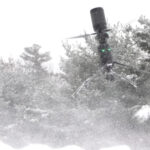The Vertical Flight Society (VFS) has announced the winners of its fourth annual Design-Build-Vertical Flight (DBVF) Competition.
Texas A&M University took first place, University of Maryland took second and the Georgia Institute of Technology took third. VFS awarded a total of more than $5,000 in the competition.
This year’s DBVF student competition was a great success. Of the original 16 teams that entered the competition in October, nine teams flew a wide range of exotic aircraft designs at the culminating event in Churchville, Maryland, on April 10–12, 2024.
The competition required the university teams to complete several deliverables throughout the year, including a final technical report, an on-site team presentation, a manually piloted flight performance course and a fully autonomous flight course.
The original 16 teams included a spread of universities across the United States, along with entrants from Malaysia, India and Canada.
This annual electric-powered vertical take-off and landing (VTOL) uncrewed aircraft system (UAS) competition seeks to encourage interest in vertical flight, electric aviation, autonomy and uncrewed systems technology, as well as small air vehicle design and fabrication.
The competition is designed to develop hands-on skills and familiarisation with eVTOL technology at the university student level and prepare the next generation of engineers and leaders to push the limits of this exciting technology into the future.
SURVICE Engineering hosted the competition flyoff for the second year in a row at its Applied Technology Operation (ATO) at Harford County Airport in Churchville, Maryland.
Teams flew their custom designed and hand-built drones in SURVICE’s flight operations area, which it operates under a Federal Aviation Administration (FAA) Certificate of Waiver or Authorisation (COA). The drones were limited to a maximum takeoff weight of 20 lb (9 kg) and a maximum dimension of 10 ft (3 m).
All nine of the teams attending the in-person competition recorded flight time, five of the teams meeting a significant amount of the flyoff competition deliverables.
Teams were required to manually pilot their aircraft over a rectangular course, with a vertical takeoff and landing on each lap to simulate the real operation of these drones and test their vehicle’s efficiency in both hovering performance and cruise endurance.
The autonomous attempt required the vehicle to take off, navigate the course, and land, all while the pilot’s hands were off the control sticks. Four teams completed the autonomous course requirement.
Subscribe to the FINN weekly newsletter

